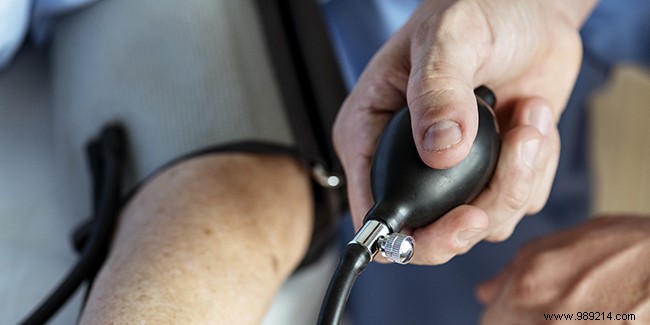
Hypertension, more specifically high blood pressure, is a cardiovascular disease that most often has no symptoms. However, it is a pathology that can have serious consequences and, among other things, be the cause of the occurrence of a stroke or neurodegenerative diseases. Hypertension affects one in three adults, especially the oldest:65% of those over 65 are affected.
Hypertension, and more specifically arterial hypertension (HTA), is a cardiovascular condition. This pathology affects many people:1 in 3 adults are affected, and especially the elderly, while it can cause serious sequelae. In France, hypertension is the most common disease. It is the leading cause of cerebrovascular accident (CVA) and one of the main causes of cardiovascular, cerebrovascular or neurodegenerative complications such as myocardial infarction or Alzheimer's disease.
Hypertension refers to a disease characterized by high blood pressure. Blood pressure is the surge caused by the pumping of blood from the heart to the blood vessels. This pressure can cause the walls of the arteries to thicken or stiffen, and form what are called atherosclerotic plaques which can eventually clog or rupture arteries.
Continuously high blood pressure also has the effect of increasing the work of the heart and being the cause of a pathology called "left ventricular hypertrophy" which can lead to heart failure.
Blood pressure, which exerts more precisely on the walls of blood vessels, is measured using two indicators:a high value (called systolic pressure) evaluated when the heart contracts to be able to propel blood towards the arteries, and a low value (the diastolic pressure) measured when the heart relaxes to be able to receive the blood sent by the different veins.
A person has arterial hypertension when either of these values, or both together, are above normal values, i.e. above 140 millimeters of mercury (mm Hg) for systolic pressure and 90 mm Hg for diastolic pressure.
The values of these two arterial pressures are measured by the doctor using a cuff placed at the level of the patient's heart, but the diagnosis of hypertension is confirmed only after measurements taken on several occasions and at different intervals of time (a few weeks) because its values fluctuate depending on the time of day, depending on physical activity, following stress or shock for example.
This is why it is necessary to confirm the presence of hypertension by another form of measurement:either a blood pressure self-measurement, the patient measures his own blood pressure at home using a blood pressure monitor for 3 days. , 3 times in the morning and 3 times in the evening; or the patient wears an armband connected to an electrical device located on the belt which measures blood pressure values every quarter of an hour for 24 hours.
A person can have hypertension without even showing symptoms of this condition which, indeed, develops silently in most cases. It is estimated that among the third of adults affected by this pathology, only half are aware of it.
This is why hypertension is often diagnosed somewhat haphazardly and therefore late.
Nevertheless, in a person with hypertension, certain symptoms may appear:permanent or strong headaches in the morning on waking; dizziness; visual disturbances; heart palpitations; sweats; nose bleeds. Malaise or difficulty breathing can also be signs of high blood pressure in some cases.
Most often, hypertension has no obvious causes and its onset cannot be explained. Nevertheless, certain risk factors have been highlighted to justify the presence of hypertension in an individual:
Being a man, from a disadvantaged social category, suffering from chronic kidney disease, being born prematurely, suffering from sleep apnea, stress, or even having a family history are also factors that can explain high blood pressure.
Arterial hypertension must be treated in order to avoid sequelae which can be severe or the occurrence of a stroke. Untreated hypertension can indeed lead to serious illnesses such as angina pectoris, myocardial infarction, artery disease (arteriopathy), chronic kidney failure, retinal disease (retinopathy) or neurodegenerative disease such as Alzheimer's disease.
Treating hypertension does not necessarily involve taking medication in the first place.
As we have seen previously, certain categories of people are more exposed than others to hypertension. To explain its occurrence, there are also so-called "modifiable" risk factors, that is to say on which it is possible to play to prevent or treat this pathology.
Indeed, a balanced diet (rich in vegetables and fruits, and low in fats of animal origin), regular physical activity, fight against overweight or obesity, consume less (or no more) alcohol ( less than 3 glasses per day for men and less than 2 for women), tobacco, limiting salt in your diet (less than 6 g/day), monitoring your diabetes, or even your cholesterol level are all lifestyle habits to promote that allow blood pressure values to return to normal levels.
If these new lifestyle habits do not lower blood pressure values after 3 months, then the prescription of so-called "antihypertensive" drugs is considered. Depending on the profile of the person with hypertension, several treatments are possible, each with their own objectives.
To promote the elimination by the kidneys of water and salt present in the body, these are thiazide diuretics; calcium channel blockers which help in the vasodilation of the arteries; ACE inhibitors and angiotensin II receptor inhibitors (ARA2); beta-blockers that lower heart rate; or centrally acting antihypertensives that regulate blood pressure in the brain.